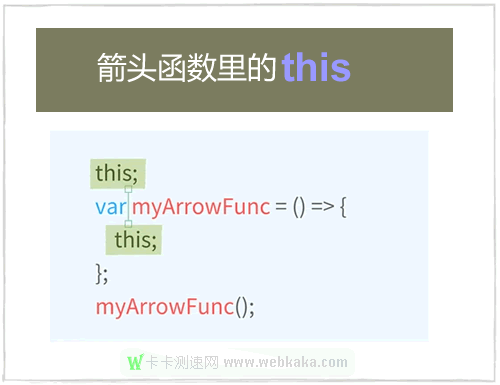【示例】分析箭头函数中的this值
作者:admin 时间:2022-6-8 22:32:13 浏览:在前文中,我介绍了常规函数中的this,然而箭头函数与常规函数不同,此外,箭头函数与常规函数的this也不同,因此,在本文中,我将介绍箭头函数中的this值。
this是定义箭头函数的封闭上下文
箭头函数不会创建自己的执行上下文,而是用this从定义它的外部函数中获取。换句话说,箭头函数在this词法上解析。

以下示例显示了上下文透明度属性:
class Point {
constructor(x, y) {
this.x = x;
this.y = y;
}
log() {
console.log(this === myPoint); // => true
setTimeout(() => {
console.log(this === myPoint); // => true
console.log(this.x + ':' + this.y); // => '95:165'
}, 1000);
}
}
const myPoint = new Point(95, 165);
myPoint.log();setTimeout()使用与log()方法相同的上下文(myPoint 对象)调用箭头函数。正如你所见,箭头函数从定义它的函数“继承”上下文。
此示例中的常规函数将创建自己的上下文——window或undefined(在严格模式下),因此,要使相同的代码与函数表达式一起正常工作,必须手动绑定上下文:setTimeout(function() {...}.bind(this)), 这很冗长,使用箭头函数是一种更简洁、更短的解决方案。
如果箭头函数定义在最顶层范围(任何函数之外),则上下文始终是全局对象(window在浏览器中):
const getContext = () => {
console.log(this === window); // => true
return this;
};
console.log(getContext() === window); // => true使用上下文修改方法也无法修改this
箭头函数与this词汇永远绑定在一起。即使使用上下文修改方法也无法修改this:
const numbers = [1, 2];
(function() {
const get = () => {
console.log(this === numbers); // => true
return this;
};
console.log(this === numbers); // => true
get(); // => [1, 2]
// 试图手动修改箭头函数上下文
get.call([0]); // => [1, 2]
get.apply([0]); // => [1, 2]
get.bind([0])(); // => [1, 2]
}).call(numbers);
无论箭头函数get()如何调用,它始终保持词法上下文numbers。用其他上下文get.call([0])或get.apply([0])间接调用,重新绑定get.bind([0])()无效。
箭头函数不能用作构造函数。将其作为构造函数new get()调用会引发错误:TypeError: get is not a constructor。
总结
本文通过几个示例,介绍了箭头函数中的this值。通过本文的学习,我们应该了解“上下文——箭头函数——this”之间的意义。
相关文章



